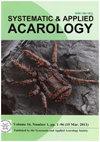New Scheloribates (Topobates) (Acari, Oribatida, Scheloribatidae) from Mexico
IF 1.2
3区 农林科学
Q2 ENTOMOLOGY
引用次数: 0
Abstract
The subgenus Scheloribates (Topobates) (Oribatida, Scheloribatidae) is recorded in Mexico for the first time. Two new species of the subgenus—S. (T.) moskovchenkoi sp. nov. and S. (T.) paramoskovchenkoi sp. nov.—are described, based on adults collected from leaf litter from the karst pits in the secondary semi-evergreen tropical forest. Scheloribates (T.) moskovchenkoi is similar to S. (T.) tibetensis in the presence of heterotridactylous legs and long bothridial seta with elongate, lanceolate head having setiform apex, but it differs from the latter by the number of notogastral setae, the different length of notogastral setae, in having sparse small foveolae in dorsoanterior and dorsocentral parts of notogaster, the position of saccule Sa, the presence of tubercle-like process on the trochanter IV, and the absence of translamella. Scheloribates (T.) paramoskovchenkoi is similar to S. (T.) moskovchenkoi in the presence of bothridial seta with elongate, lanceolate head having setiform apex and 13 pairs of notogastral setae, but it differs from the latter in having monodactylous legs and five pairs of notogastral sacculi, strongly reduced pteromorph, the presence of tooth-like process on the trochanter IV, the presence of two longitudinal dorsodistal carinae and concavity between them on the leg tarsi I, II, and in the absence of foveolae on the notogaster and ventrobasal tooth on the leg tibiae I, II.墨西哥棘螨属新种(棘螨亚纲,棘螨亚纲,棘螨科)
在墨西哥首次记录到鳞螨亚属(鳞螨目,鳞螨科)。标题亚属二新种。(T.) moskovchenkoi sp. nov.和S. (T.) paramoskovchenkoi sp. nov. -基于从热带次生半常绿森林喀斯特坑凋落叶中收集的成虫进行了描述。莫斯科雪螺(T.)与西藏雪螺(T.)相似,均具有异三叉腿,双侧刚毛长,头长披针形,顶具刚毛,但与西藏雪螺的不同之处在于:背胃刚毛的数量,背胃刚毛的长度不同,背胃刚毛的背前部和背中央部分有稀疏的小凹窝,囊状Sa的位置,粗隆IV上有结核样突起。以及跨片胞体的缺失。paroskovchenkoi与S. (T.) moskovchenkoi相似,其双侧刚毛呈细长状,披针形头有刚毛状先端和13对非胃侧刚毛,但与S. (T.) moskovchenkoi不同的是,它具有单趾腿和5对非胃侧小囊,翼形强烈减少,转子IV上存在齿状突,在腿跗I, II上存在两个纵向背远端隆和它们之间的凹。在没有窝窝的情况下在腿胫骨上没有腹基牙1,2。
本文章由计算机程序翻译,如有差异,请以英文原文为准。
求助全文
约1分钟内获得全文
求助全文
来源期刊

Systematic and Applied Acarology
ENTOMOLOGY-
CiteScore
2.20
自引率
33.30%
发文量
152
期刊介绍:
Systematic and Applied Acarology (SAA) is an international journal of the Systematic and Applied Acarology Society (SAAS). The journal is intended as a publication outlet for all acarologists in the world.
There is no page charge for publishing in SAA. If the authors have funds to publish, they can pay US$20 per page to enable their papers published for open access.
SAA publishes papers reporting results of original research on any aspects of mites and ticks. Due to the recent increase in submissions, SAA editors will be more selective in manuscript evaluation: (1) encouraging more high quality non-taxonomic papers to address the balance between taxonomic and non-taxonomic papers, and (2) discouraging single species description (see new special issues for single new species description) while giving priority to high quality systematic papers on comparative treatments and revisions of multiple taxa. In addition to review papers and research articles (over 4 printed pages), we welcome short correspondence (up to 4 printed pages) for condensed version of short papers, comments on other papers, data papers (with one table or figure) and short reviews or opinion pieces. The correspondence format will save space by omitting the abstract, key words, and major headings such as Introduction.
 求助内容:
求助内容: 应助结果提醒方式:
应助结果提醒方式:


